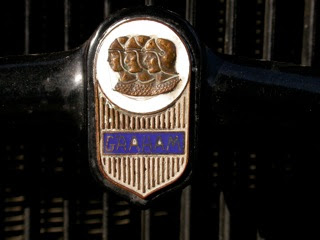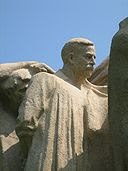
I was browsing through some photographs recently that I had taken at an old car show. I came across this picture which shows the logo that adorned the radiator of an old automobile at the show. If you look beneath the three knights you can see the word "Graham". I became idly curious about Graham cars and started doing a little digging to find out more.
The Graham brothers (there were three of them) came from an Indiana farm background and near the turn of the 20th century they got involved with a glass-making factory. The company was one of the predecessors of what eventually became Libby-Owens-Ford (LOF) that became a major supplier of safety glass to the automotive industry. The brothers got interested in manufacturing light trucks based on modifying Ford's Model-T's. Eventually, they set up their own truck manufacturing business and began supplying trucks to Dodge. Dodge bought the brothers out but they weren't out for long. The Grahams took their profits and bought the recently-defunct Paige Motor Car Company and renamed it (surprise) the Graham-Paige Motor Company. They began producing cars in the late twenties when there was still a little "roar" left in the economy. By 1930, they had dropped the Paige part of the name and the cars became badged as simply Graham (although the public continued to call them Graham-Paige).
So what was the symbolism of the logo? The icon on the radiator in my photo was designed for the Grahams by the (then) well-known Chicago sculptor, Laredo Taft (1860 - 1936). Now I became curious about Mr. Taft. Digging around, I found the following:
The badge is meant to represent the three Graham brothers as valiant white knights that come to the rescue of troubled car companies. I guess the brothers actually felt that way about themselves.
Taft, as it turns out, usually designed much bigger works starting with statues on the Horticultural Building in the 1893 Chicago World's Columbian Exposition. His largest work is a 126 foot-long sculpture in Washington Park in Chicago, entitled Fountain of Time.

The sculpture honors the 100 years of peace that had endured between the U.S. and Great Britain beginning with the Treaty of Ghent in 1814. It shows 100 figures at all stages of life parading past Father Time. Taft even put himself in the sculpture as you can see in this photo.

The sculpture itself is inspired by Henry Austin Dobson's poem, "Paradox of Time". The poem contains the line:
Time goes, you say? Ah no, Alas, time stays, we go.
But I digress. Back to the Graham boys. Time was not kind to the Graham Automobile Company. The company creaked on through most of the Great Depression losing money every year except 1933. By 1940 with World War II approaching, the company switched to government contracting and became profitable. No Graham cars were ever built again. Even then, curiously, the government rescued car makers from total demise!
So my photo of the radiator ornament taught me a lot. I now know something about the Grahams, Lorado Taft, and the unlikely connections between technology and art. Who would have guessed?
No comments:
Post a Comment